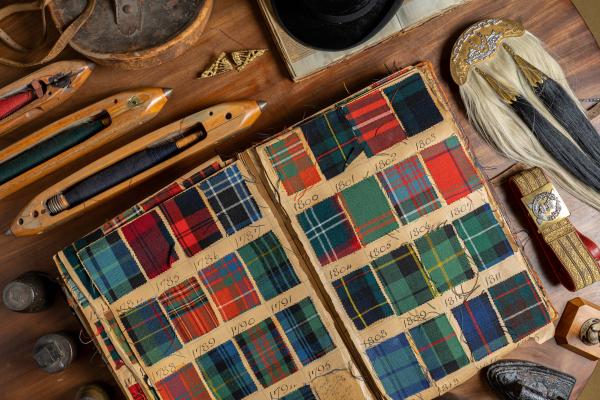
After the dark times of the 1746 Dress Act that saw the wearing of Tartan, Kilts, and Highland wear outlawed in Scotland, the 1800’s and beyond saw a reversal of fortunes for the Kilt.
Eventually the restrictions on Highland wear were removed, and Highland Societies were setup with the aim of promoting the wearing of the Kilt once again. During this time, a great boost was given to the image of the Kilt and tartan by the visit of King George IV to Scotland in 1822, where he arrived from England fully kitted out in a Highland Outfit (as advised by Sir Walter Scott).
While some looked on the visit in a negative light, the overall reaction was positive. Kilts were once again an iconic symbol of Scotland and linked to the Scottish identity. These fought-for values are something that we, at Kinloch Anderson, hold very close to our heart as we press on towards tartan innovation through tradition – taking inspiration from what has come before as we seek to sustainably innovate particular areas of our business.
Royal inspiration
Since King George's visit in 1822, the popularity of tartan has grown throughout the years with various different influences, especially within the Royal family. Queen Victoria herself wore dresses made from various tartans, which sent out inspiring fashions statements, as does the dress sense of the young royal today – even the royal children!
Regiments who served the Queen and The British Empire also wore tartan – Scottish regiments wore tartan, Indian regiments wore tartan and, indeed, all of these were serviced by Kinloch Anderson.
Tartan ambassadors
Fast forward to the early 1900s, Sir Harry Lauder, the Scottish singer and comedian who toured the world for over 40 years wearing full Highland regalia, can be credited as being one of Scotland's greatest ambassadors. According to Sir Winston Churchill he "rendered measureless service to the Scottish race", which we wholeheartedly agree with.
The Bay City Rollers, a Scottish pop band who by early 1975 were the biggest group since The Beatles, were deemed the "tartan teen sensation from Edinburgh" and distinctively wore core-length tartan trousers and tartan scarves. The group are incredibly responsible for making tartan increasingly accessible, demonstrating its versatility in not being limited in its use in the garments of older individuals, or those of military rank. (Tailored for Scotland, by Deirdre Kinloch Anderson)
This lasting influence is something we at Kinloch Anderson see every day in the demographics that visit our showroom and choose to shop with us online. Thanks to the tartan ambassadors that proliferated the 1900s, younger generations are continuing to enjoy the intrinsic heritage value of Highlandwear articles and are still passing the tradition down through their families as the generation above them did also.
Product diversification
When it comes to womenswear, tartan has skilfully found its way from the arisaid and the tartan sash to every skirt style imaginable: kilted, mini, maxi, box pleated, high waisted, bias cut, and so many more. In the 1980s, the Kinloch Anderson tartan and tweed skirts were at the height of fashion and could be found in all the major cities of Europe, as well as in America and the Far East.
In the 21st century, the Kinloch Anderson 1868 Collection was designed as a modern menswear range based on Kinloch Anderson's former tailoring heritage. It was launched in 2016 for sales in the shop and online. It's 'fashionable' concept remains valid, and the 1868 Kinloch Anderson jackets have been a particular success.
Today's media
However, probably the biggest impact on how tartan fashion is portrayed now is from the media. In the 1860s, fashion was found in magazines – such as Harpers Bazaar. Then in the next century, as colour television moved into more and more homes until there is now hardly a dwelling place without one, it put fashion in front of people every day. The impact was huge.
Neither should we forget the film industry; such film as Rob Roy (1995), Braveheart (1995) and more recently Outlander, have increased a demand for kilts and Scottish clothing as seen in these films and TV programmes. (Tailored for Scotland, by Deirdre Kinloch Anderson)
Having been heavily present in the luxury tartan fashion industry for 6 generations, Kinloch Anderson have seen the resurgence in popularity of tartan first hand. We've seen trends come to stay, as well as fads that fade as soon as they've landed, but one thing without a doubt has remained. The intrinsic heritage value of tartan – a sense of belonging with roots so deep and so rich that it remains timeless throughout the generations that continue to proudly wear and showcase their ancestry.


